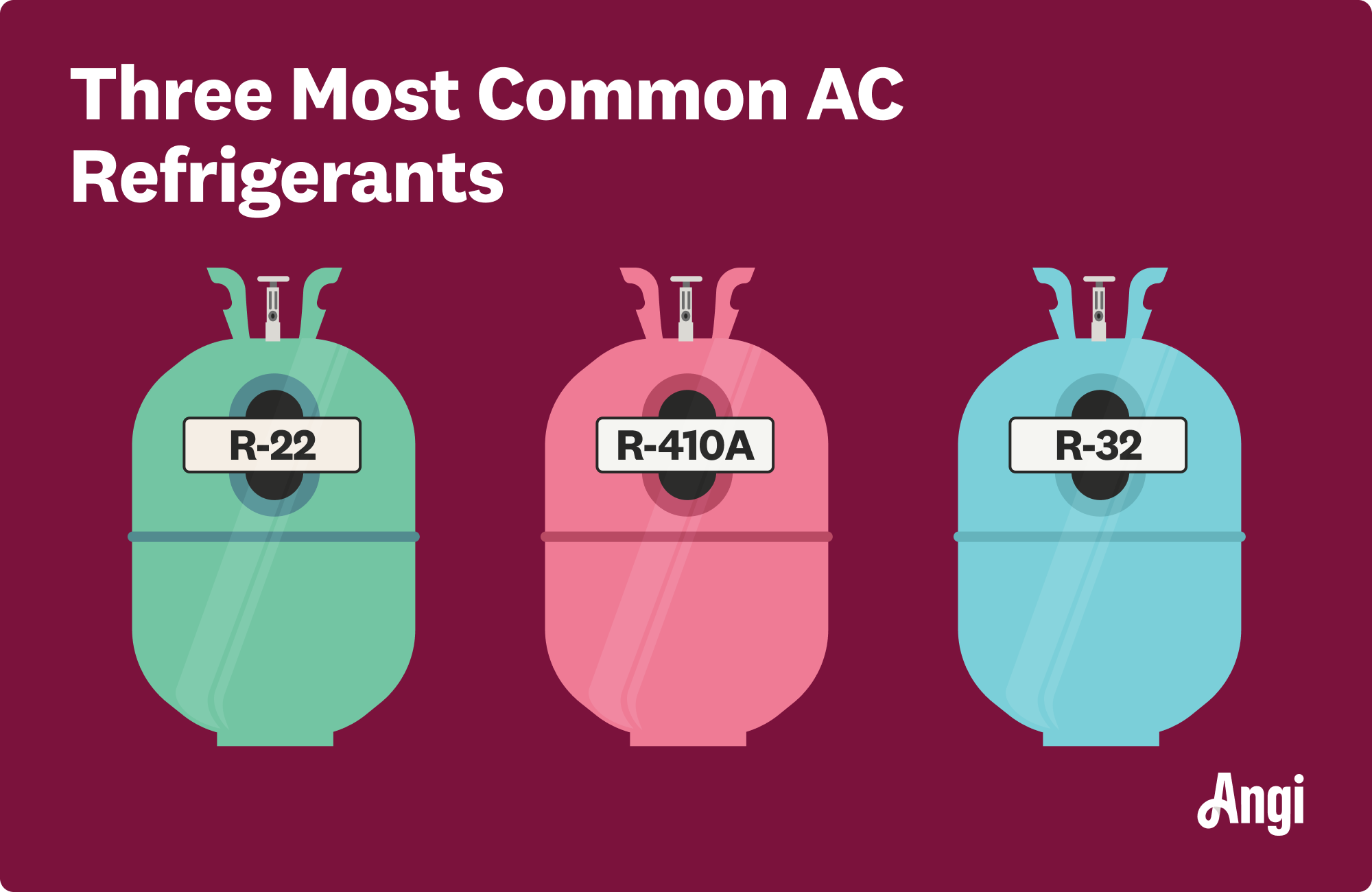How Much Does R-22 Refrigerant Cost per Pound? [2025 Data]
R-22 refrigerant costs $125 per pound on average, but can range from $50 to $250 per pound. Keep in mind you cannot purchase R-22 refrigerant without an HVAC pro.


Before 2010, the AC and HVAC systems that cooled our homes and overly chilled our offices ran on R-22 refrigerant. The Environmental Protection Agency has since discovered that R-22 depleted the ozone layer and began phasing it out between 2010 and 2030. R-22 refrigerant prices range from $90 to $250 per pound.
Since you'll need between 6 and 12 pounds to refill a home AC, costs can reach between $660 and $2,400 for a refill of R-22 refrigerant.
The EPA prohibits handling AC refrigerant without a license. This is one DIY project you shouldn’t try—having a licensed AC repair technician refill your AC refrigerant is the safest (and legal) option.
How Much Does R-22 Freon Cost per Pound?

The cost of R-22 refrigerant per pound is $90 to $150, plus the cost of installation and other service fees. Consulting an AC repair professional near you will be the best way to determine your price range per pound for R-22 refrigerant.
If your pre-2010 AC is still trucking along, there's a solid chance you'll need R-22 if you experience a refrigerant leak. After 2010, the EPA banned the production of systems that required this substance, and most systems switched to the safer R-410A.
It's important to note that a high-functioning HVAC system only requires a refill if something is wrong. For example, you may have a refrigerant leak or need other common AC repairs. As your pro fixes your system, you may also see a $50 to $150 recovery charge on your bill, now required by the EPA.
The volatility of refrigerant prices makes it difficult to predict how much you'll pay for a top-up. Still, it's essential to look at your options if your older HVAC needs more refrigerant quickly.
Why Does R-22 Cost So Much?
With the cost of R-22 averaging $50 in 2017 and up to $150 recently, many homeowners are wondering why the price of R-22 refrigerant is so much. The answer is simple—it’s the law of supply and demand.
Since the EPA banned the production and importation of R-22 back in 2020, many HVAC distributor companies stocked up on it before it disappeared. Essentially, HVAC companies are working off of a supply that is now four years old, and that supply is dissipating fast. Since there will be no additional supply of R-22, you can expect the cost per pound to continue to rise until the entire supply is used up, or until 2030, when the final phase of the R-22 ban takes effect.
R-22 Refrigerant Price Factors
Always keep in mind that refrigerant does not naturally deplete over time. You only need to top up your system if you have a leak. Symptoms such as condensation on your AC or warm air blowing from the vents are signs that it's time to have a local AC repair pro check your refrigerant lines.
If you need to replace R-22 refrigerant because of a leak, here are the most important factors that can sway your bottom line.
Size of the HVAC Unit
Manufacturers use tonnage and BTUs (British Thermal Units) to measure an air conditioner's size. Most air conditioners range between 1 and 5 tons. Since an air conditioner uses an average of 2 to 4 pounds of refrigerant per ton, a 3-ton AC will need an average of 9 pounds.
With the cost of R-22 refrigerant increasing each year, it can cost a pretty penny to recharge larger systems that still use the refrigerant. Here's what to expect for the cost of refrigerant by HVAC size.
| HVAC Size (Tons) | Refrigerant (Pounds) | Average Cost, Labor Plus Materials |
|---|---|---|
| 2 | 6 | $660–$1,000 |
| 3 | 9 | $930–$1,500 |
| 4 | 12 | $1,200–$1,900 |
| 5 | 15 | $1,500–$2,400 |
Age of Your AC Unit
If you own an air conditioner designed before the phaseout, the price of R-22 will naturally raise your overall costs. Not only will you pay more for the price of R-22, but you will need an HVAC pro who is familiar with your system.
Older systems also come with related repairs and line items, such as the cost of fixing a leak or an AC compressor. In some cases, it may be more cost-effective to replace your air conditioner with one that accepts an up-to-date refrigerant.
Location
While your HVAC team will know where to order R-22 from anywhere in the country, shipping prices will vary depending on availability. Fewer and fewer wholesalers have R-22 available, and since importing it into the country isn't possible, you could live somewhere without easy access to the refrigerant.
Also, the price of an AC recharge will vary based on the cost of living in your area. It may cost more in densely packed cities with high demand for HVAC pros than in quiet suburbs.
Labor
Overall, labor for HVAC repairs costs between $100 and $250 per hour, so the cost of recharging your AC with R-22 will depend on the size of the related repair. And since it is illegal to handle or dispose of R-22 yourself, be sure to include this in your budget.
R-22 vs. R-410A vs. R-32

Knowing the differences between refrigerants can be tricky, and it can be even harder to determine which ones are still widely used.
| R-22 | R-410A | R-32 |
|---|---|---|
| $90 to $150 per pound | $50 to $90 per pound | $10 to $20 per pound |
| Leaks are incredibly toxic, leading to high ozone-depleting issues. | Has three times more global warming potential than R-32. | Can reduce electricity consumption by up to 10%. |
| As of 2020, it is illegal to manufacture or import. Can use recovered, recycled, or reclaimed R-22 until the final phase of ban in 2030. | HVAC systems using R-410A will no longer be manufactured or imported after January 1st, 2025. However, they can be installed until January 1st, 2028. | As of January 2025, no current EPA petition or ban is in place to prohibit use through 2029. |
Nowadays, it's more pertinent to know the cost of R-410A, a commonly used refrigerant in modern systems. However, because of the American Innovation and Manufacturing (AIM) Act, the EPA is also in the process of limiting this refrigerant. Additional restrictions on ozone-depleting hydrochlorofluorocarbons (HCFCs), including R-410A, will trigger over the next couple of years. And while R-410A proves less of an environmental threat than R-22, even safer options are making their way into the market.
For example, you will most likely encounter HVAC systems that use the refrigerant R-32, which has a much lower ozone-harming potential. The cost of these is currently far less than the cost of R-22 per pound.
Just a note that you may still hear the term “Freon” used when topping up a newer system with R-22. So, what is Freon™? Similar to how we use brand names interchangeably for other household items, you may see all types of refrigerant referred to as “Freon,” but Freon™ is only one brand-name refrigerant on the market.
DIY R-22 Refill vs. Hiring a Pro
The EPA only allows licensed professionals to purchase ozone-depleting substances, including R-22—a wise move considering it’s a dangerous chemical with the power to damage your AC if mishandled or installed incorrectly.
Also, running low on refrigerant of any sort typically means you have a leak or other damage. While tackling AC repairs on your own is not advisable—and in some cases, illegal—you can try troubleshooting common AC issues or staying on top of AC maintenance during the summer. Some DIY steps you can take to keep your AC running smoothly include:
Cleaning or replacing your AC filter
Flushing the condensate line regularly
Checking your condensate pan for damage
Monitoring your thermostat
Clearing debris away for outdoor compressors
Investigating condensation on your AC
How Angi Gets Its Cost Data
Home is the most important place on earth, which is why Angi has helped more than 150 million homeowners transform their houses into homes they adore. To help homeowners with their next project, Angi provides readers with the most accurate cost data and upholds strict editorial standards. We extensively research project costs to develop the pricing data you see, so you can make the best decisions for you and your home. We rely on reputable sources, including the U.S. Bureau of Labor Statistics, academic journals, market studies, and interviews with industry experts—all to ensure our prices reflect real-world projects.
Want to help us improve our cost data? Send us a recent project quote to costquotes@angi.com. Quotes and personal information will not be shared publicly.
Frequently Asked Questions
Thankfully, many home warranties will cover R-22 replacement costs, and sometimes they even cover upgrading your HVAC. Since not all plans are the same, check if a home warranty is worth it before adding it to your annual costs. Most cost between $300 and $600 per year, which can be handy if you end up with an R-22 leak.
You can buy R-22 refrigerant for your home air-conditioning system through your local AC repair specialist, who can also refill your R-22 system as needed. You may find that the cost of R-22 has gone up due to shortages as the EPA banned this refrigerant. Ask your pro to inspect your system for any leaks or issues.
R-22 refrigerant is still available but expect higher costs. Since R-22 refrigerant is an ozone-depleting substance (ODS), the EPA only allows certified technicians to purchase it. Therefore, homeowners cannot purchase it directly, and you’ll have to go through your HVAC specialist if you have an air-conditioning system from before 2010 that runs on R-22.
You will only need to refill your AC with refrigerant if it has a leak. Otherwise, a modern, well-maintained AC will most likely never need a recharge. You may notice a leak in an older system if your bills are higher, you hear a hissing sound, or if the air is blowing out hot.
Due to pressure and chemical differences, using R-410A in an older system built to run on R-22 is not safe or effective. Adding R-410A to an R-22 AC can result in severe damage to the unit. Always work with a licensed AC repair specialist to find the best solution for your older AC setup.





- Furnace Repair
- Air Conditioning Repair
- HVAC Repairs
- Furnace Installation
- Wood & Pellet Stove Repair
- Dehumidifier & Humidifier Repair
- Heat Pump Companies
- Swamp Cooler Repair
- Wood Stove Services
- HVAC Companies
- Commercial A/C Repair
- Geothermal Installation
- Air Conditioning Installation
- Boiler Repair
- 24 Hour Furnace Repair
- Geothermal Repair
- Heat Pump Repair
- Humidifier Installation
- Thermostat Repair
- Thermostat Installation
- Nest Installation
- Heating & Cooling
- Heating Repair
- Furnace Cleaning
- Furnace Tune-Up
- HVAC Technicians
- Subcontractors
- Furnace Maintenance
- Plumbing & Heating Companies
- Wood Stove Inspection
- Mini Split Installation
- Wall Heater Repair
- Duct Installers










